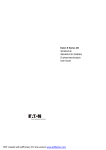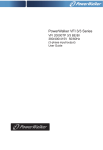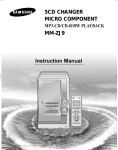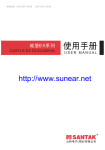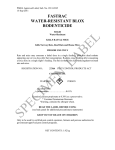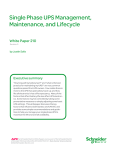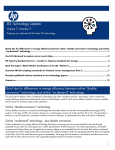Download BlueWalker PowerWalker VFI 40000TP 3/3 BX
Transcript
PowerWalker VFI 3/3 Series VFI 20000TP~40000TP 3/3 BX 380/400/415V 50/60Hz (3-phase input/output) User Guide EN ©2013 BlueWalker GmbH All Rights Reserved The contents of this manual are the copyright of the publisher and may not be reproduced (even extracts) unless permission granted. Every care has been taken to ensure the accuracy of the information contained in this manual, but no liability can be accepted for any errors or omission. The right to make design modifications is reserved. Safety Instructions Operation Safety 1.Prior to the application, please read “Safety Instructions” carefully to ensure correct and safe application. Please keep the user manual properly. 2.During operation, attention should be paid to all warning symbols and operations should be followed strictly as required. 3.Equipment is not supposed to be used in environment that directly exposed to the sunlight or raindrops or in humid. 4.The equipment should not be installed close to area of thermal sources or any area where there is presence of devices such as electric heaters and furnaces. 5.Make sure the safety space should be left for proper ventilation when placing UPS. Refer to the instructions during installation. 6.Dry items should be used for cleaning. 7.In case of a fire hazard, dry powder extinguisher should be used properly. Using liquid fire extinguisher may result in electric shock hazard. 8.Storey bearing capacity of machine and batteries should be taken into consideration prior to installation. Electric Safety 1.Before electricity is switched on, make sure earthing is properly done and wire and battery polarity are correctly connected. 2.When UPS relocation or wire reconnection is necessary, AC should be switched off and UPS should be completely turned off, otherwise there might be a danger of electric shock because output terminal might be still electrified. 3.Please use PowerWalker specified appendix devices and accessories. Battery Safety 1.Battery service lifetime will be shortened as ambient temperature rises. Replace batteries periodically to guarantee normal UPS performance and sufficient back-up time. 2.Only personnel with proper expertise can carry out the maintenance of accumulator batteries. 3.Replacement of accumulator batteries requires a match of same type and model with equal quantity. 4.As accumulator batteries may contain potential electric shock and short-circuit current danger, to avoid accidents that might be thus resulted, the following warnings should be observed during battery replacement: A.Do not wear watches, rings or similar metallic items; B.Use insulated tools; C.Put on rubber shoes and gloves; D.Do not place metallic tools or similar metallic parts on the batteries; E.Switch off load connected to the batteries before dismantling battery connection terminals. 5.Do not expose accumulator battery to fire in order to avoid possible explosion that might endanger physical safety. 6.Non-professionals are not allowed to open or destroy accumulator batteries for electrolytes in batteries contain strong acid and other dangerous substances which will cause damages to both human skins and eyes. Should electrolytes come into any contact with human body unintentionally, rinse with clean water and seek medical advice. 7.Do not cause battery positive and negative polarity short circuit otherwise electric shock or inflammation may occur. Maintenance 1.Working environment and storage means can affect the service term and reliability of this product to some extent. Therefore, the product is not suitable for performance in the following environment: Locations where temperature exceeds the maximum or goes below the minimum temperature as required by technical specifications or humidity is improper (temperature range: 0℃ ~ 40 ℃ ; relative humidity range: 20% ~ 90%). Locations where vibration and collision are constant; Locations where metallic dusts, corrosive substances as well as salts and inflammable gases are present. 2.For long-term inaction, UPS (without batteries) should be kept in dry environment with temperature ranging from -25℃~ +55℃ . Before start-up, ambient temperature should be brought back to 0 or above for a certain period of time. EN Contents 01 Chapter 1 Brief introduction--------------------------------------1.1 Product introduction-------------------------------------------------- 01 1.2 Frequently used symbols---------------------------------------------- 01 02 1.3 Product standard------------------------------------------------------1.4 Technical parameters and specifications------------------------------------03 Chapter 2 Exterior appearance-----------------------------------05 05 2.1 Unpacking inspection---------------------------------------------------2.2 Outside view drawing------------------------------------------------- 06 2.3 Panel instructions----------------------------------------------------- 08 Chapter 3 Installation instructions---------------------------------10 3.1 Single machine installation----------------------------------------------10 3.2Parallel machine installation--------------------------------------------- 12 3.3 Procedures of connecting battery box to UPS------------------------------- 13 Chapter 4 Operation------------------------------------------- 14 4.1 Single machine operation------------------------------------------------14 4.2 Parallel machine operation----------------------------------------------21 Chapter 5 Communication interface-------------------------------23 Chapter 6 Transportation, maintenance and troubleshooting-----------26 28 Appendix 1 Light reference table---------------------------------- Chapter 1 Brief introduction 1.1 Product introduction PowerWalker VFI 3/3 Series products are high-efficiency and high-performance, doubleconversion three phase input and three phase output UPS, unit capacity ranging between 20KVA-40KVA. Categorized by capacity, the products can be further divided into 20KVA, 30KVA and 40KVA. This series not only provides perfect solution for power source protection and successfully solves problems such as blackout, boost, brownouts, sags, decaying, oscillation, high voltage impulse, voltage fluctuations, surges, harmonic distortion, disturbances, frequency fluctuation etc, but also enhances adaptability to complicated working environments so that the application fields is well extended to computer equipments, communication equipments and other controlling equipments with good adaptability to complicated industrial environments as well. Therefore, The Series products can be applied in a diversified multi-industries field such as telecommunications, financing, transportation, government, manufacturing and energy sectors. PowerWalker VFI 3/3 Series products are also capable of ECO mode. Under ECO mode, UPS is powered by AC supply while in case of abnormal AC supply UPS will be supplied by accumulator battery after conversion through inverter. As the energy conversion efficiency reaches as high as 98% under ECO mode when there is normal AC supply, the energy saving effect of UPS is remarkable. Meanwhile, when UPS inverter is at start-up mode but without power output, which is similar to hibernation mode, the inverter life term can be largely extended. At normal AC supply, except that ECO mode displays a relatively poorer power delivery quality compared to normal double conversion mode, it is capable of satisfying the needs of most power-driven equipments in today’s AC network incorporation. Remark: under ECO mode, conversion time of 0ms mode is not guaranteed and it is applicable only to single machine. 1.2 Frequently used symbols The following symbols will be frequently used in this User Manual as well as in the process of actual application, therefore, correct identification and understanding of their connotations prove necessary. 1 EN Remark: Proper attention should be given to all warning symbols on the equipment and no tearing or damaging of these symbols is allowed. 1.3 Product standard The Series products are up to the following safety standards: The Series products are up to the following level of EMC requirement: 2 WARNING:This is a product for commercial and industrial application in the second environment-installation restricitions or additional measures may be needed to prevent disturbances EN 1.4 Technical parameters and specifications Input Wire connection: three phase four wire +grounded Voltage: 380 ×(1 +25% / -45%)VAC (when input voltage<75%, output power derating is required) Frequency: 40Hz-70Hz Power factor: over 0.99 Bypass voltage range: 380(1± 15%) Output Wire connection: three phase four wire + grounded Voltage: 380 ×(1 ± 1%) VAC or 220 ×(1 ± 1%) VAC (with balanced load) Power factor: 0.8 Frequency error: ± 8% at 50Hz (track bypass frequency input; when frequency exceeds ±8% or under the mode of battery power supply, frequency output should be ± 0.1% of the rated amount.) Overload time: exceed 10min (110% < load ≤ 125%) exceed 1min (125% < load ≤ 150%) Unbalanced load capacity: 100% Battery voltage and charging voltage Operating environment Ambient temperature: 0℃~ +40℃ Ambient humidity: 20% ~ 90 % 3 Altitude: below 1000m Storage temperature: -25℃~ +55℃ Remark: when UPS has been stored under a temperature of 0℃ or has been inactive for a long time, it is suggested that prior to start-up of UPS environmental temperature should be brought back to 0℃ or above for 2 hours. General specifications VFI 20000TP 3/3 BX Machine size(mm) L*W*H 643*420*956 VFI 30000TP 3/3 BX 710*470*1150 110 160 VFI 40000TP 3/3 BX 710*470*1150 114 164 MODEL NO 4 N.W(kg) G.W(kg) 82 122 Chapter 2 Exterior appearance 2.1 Unpacking inspection EN 1.Unpack and there should be: Winpower disc User Manual 2. Check whether UPS is damaged during the process of transportation or not. Should any damage be observed or parts be found missing, do not start the machine. Forwarder and distributor should be immediately advised. Remark: prior to transportation make sure of the height of the door and other obstacles standing in the passage. Refer to the following figure for the dismantling of machine cabinet: 5 2.2 Exterior figure Exterior figure of VFI 20000TP 3/3 BX UPS EXT.BATTERY TEMP PROBE SERVICE AS400 EPO RS485 RS232 PARALLEL intelligent slot LCD panel Extended slot Button LED indicator light Fan Front view 6 Rear view CHGR FAN EN Maintenance switch Main Ⅱ(Optional kit) Main Ⅰ Front view (without front panel) Exterior figure of VFI 30000TP 3/3 BX,VFI 40000TP 3/3 BX UPS LCD panel EXT.BATTERY TEMP PROBE RS232 AS400 EPO RS485 SERVICE PARALLEL intelligent slot Extended slot Button LED indicator light FAN Front view Rear view 7 CHGR FAN Maintenance switch Main Ⅱ(Optional kit) Main Ⅰ Front view (without front panel) 2.3 Panel instructions ① AC: this light and inverter light will turn “green” when UPS is powered directly by AC; ② Inverter: this light will turn “green” when UPS is loaded through the inverter; ③ Battery: this light will turn “yellow” when UPS is powered by batteries; ④ Bypass: this light will turn “green” when UPS is power loaded by AC through bypass. 8 ⑤ Fault: this light will turn and stay “red” with continuous warning tone being given off in case of UPS abnormal function; or flash “red” with intermittent warning tone being given off. ⑥ LCD: display UPS condition. ⑦ :Confirm/Enter; press this button to select a menu or confirm an operation. ⑧ :PageDown; press this button to switch to next screen display under the same menu. ⑨▲ :PageUp; press this button to return to next screen display under the same menu. ⑩ Esc:Escape; press this button to return to previous menu or cancel a certain operation. Remark: Refer to Appendix 1 for detailed information of LED in accordance with UPS condition. 9 EN Chapter 3 Installation instructions 3.1 Single machine installation 1) The installation of this unit must be performed in compliance with the electrical code by professional personnel. 2) Install the UPS in a clean and stable environment that is free of vibration, dust, high humidity, flammable gas, flammable liquid or caustic substance. 3) To ensure normal UPS performance, ambient temperature should range between 0℃ 40℃ . If temperature exceeds 40℃ , maximum load should be decreased progressively by 12% of the rated amount along with every increase of temperature by 5℃ . The maximum ambient temperature for normal UPS performance should not exceed 50℃ . 4) It is suggested that battery pack should work within a temperature range from15℃ to 25℃ . 5) Altitude for normal UPS function should not exceed 1000m. Should UPS be intended for application above 1000m, progressive decrease of rated output should be applied as listed in the following chart: 6) The Series adopt forced fan cooling and installation spot should make allowance for ventilation. Meanwhile, inside maintenance should be carried out from the front side and therefore maintenance space should also be considered in advance. Refer to the following figure for installation space. 7) External batteries of The Series UPS require serial connection of two groups of 14-16 batteries (12VDC per battery) with the same capacity, nominal voltage 10 for each group being168VDC-192VDC. Battery capacity and number of group can be selected at your option. Battery pack must be equipped with DC switch (it is suggested that selection of DC switch should be in line with installation drawing for wire connection). 8) Brake pad: use wrench 19# in clockwise direction so as to screw the brake pad down to the ground, keeping the machine from moving. 9) Installation and wire connection diagram (Optional kit) 10) Jumper list for the UPS Machine Model Rated power VFI 20000TP 3/3 BX VFI 30000TP 3/3 BX VFI 40000TP 3/3 BX 20KVA/ 16KW 30KVA/ 24KW 40KVA/ 32KW input live Input wire switch Diameter Output live Battery positive wire and negative Diameter wire Diameter/ battery Diameter 10AWG/ 3Φ63A/ 10AWG/ 8AWG/ 380VAC 6mm2 10mm2 6mm2 6AWG/ 8AWG/ 3Φ63A/ 8AWG/ 380VAC 10mm2 16mm2 10mm2 4AWG/ 6AWG/ 3Φ63A/ 6AWG/ 380VAC 16mm2 25mm2 16mm2 Ground wire Diameter Output N wire Diameter Battery switch 8AWG/ 10mm2 6AWG/ 16mm2 4AWG/ 25mm2 8AWG/ 10mm2 6AWG/ 16mm2 4AWG/ 25mm2 3Φ125A/ 250VAC 3Φ150A/ 250VAC 3Φ200A/ 250VAC 11 EN Remark: 1. For the Series UPS, input neural line should be directly connected to input “N” terminal of UPS wire connection terminal bay without AC input idle-run; 2. When single-phase current exceeds 100A, switches of protective atmosphere should be equipped with arc control devices; 3. Battery positive/negative wire size: indicates UPS and battery box wire size; red wire signifies the positive polarity and black wire the negative,while blue wire the neutral. 4. Proper positioning in line with above specifications should be done prior to installation. 11) Sequence of phase A, B and C should be properly connected otherwise UPS will display wrong phase sequence fault and start-up will fail. 12) Connect one end of communication line to terminal RS232 of UPS while the other end to terminal RS232 of PC. PC supervision over UPS can be realized after successful installation of WinPower supervising software on PC. 3.2 Parallel machine installation 1) Follow installation instructions for general installation requirements. 2)Ventilation spacing between machine flanks should be a minimum of 10cm and a minimum of 50cm (considering the space for replacing fans) for the back for machine. 3) Input wiring for each set of UPS should follow the requirements for that of single unit. Each UPS input should be connected to the same input patch board. 4) Each UPS output wire should be connected to the output patch board, from which wires are distributed for load as illustrated in following figure. Remark 1: common battery pack is applicable in parallel machine mode; Remark 2: each battery pack should be of the same model from the same manufacturer; Remark 3: requirement of output wiring length: When the lead from the output terminal of each set of UPS to the output patch board is less than 20m, wire difference should be less than 20%; When the lead from the output terminal of each set of UPS to the output patch board is longer than 20m, wire difference should be less than 10%. 12 EN 3.3 Procedures of connecting battery box to UPS 1. Make sure that UPS input and output terminals are uncharged; 2. Turn off the battery switch on battery box; 3. Connect “+”, “N” and “-“ of battery to the corresponding terminal bay of UPS; 4. Use multimeter (DC Voltage) to measure the voltage of positive and negative batteries as well as positive and negative polarity. Remark: remove the panel on the terminal bay and connect “+”, “N” and “-” wires from UPS terminal bay to “+”, “N” and “-” of the battery box. Non-professionals are not allowed to carry out the task otherwise electric shock may occur. 13 Chapter 4 Operation 4.1 Single machine operation 1. Make sure A, B and C phase sequences are correctly connected and then supply power to UPS. 2. Turn on the switch on battery box (make sure that the “+”, “N” and “-” of terminal bay are in accordance with those on the battery box). 3. Switch on “input breaker” (Line input breaker: Main Ⅰ ; bypass input breaker: Main Ⅱ (if assembled)) on UPS and fans start to rotate for UPS self-inspection. Main menu can be accessed within about 4sec and then operations should be carried. Remark: the following drawing takes VFI 20000TP BX as an example and statistics are only for reference. 1)Power on 2)Automatic access within about 4s POWERWALKER VFI 20000TP 3/3 3)Press ESC to access or automatically access within 1min with no button being pressed 14 4)Press ▼ to obtain the below informtion EN 5)Press ▼ again to obtain the below information 7)Press ▼ again to obtain the below information 6)Press ▼ again to obtain the below information 8)Press ▼ again to obtain the below information VFI 20000TP 3/3 15 Remark: when malfunction occurs, “x” will appear at the lower right corner of the picture while when warning occurs “ ” will appear at the same position (as illustrated in the below picture with battery mode as an example). 4. Start-up action (press ESC to exit the above picture) 1)Switch-on picture 2)Press ENTER 3)Select “Yes, Confirm” to switch on the machine 4)Normal Switch-on LOADING 16 5)Battery power supply (switch off line input breaker) EN 5. Switch-off action (press ESC to exit above picture) 1)Switch-off picture 3)If it is in parallel machine mode, the following will appear 2)If it is in single machine mode, the following will appear 4)Press ENTER 17 LOAD LOAD 5)Select “Yes, Confirm” to switch off the machine 6)Normal Switch-off LOAD Remark: If you intend to switch off only one set of UPS among the parallel machine system, select “single machine switch-off”; if switch-off is intended for the entire parallel machine system, select “parallel machine switch-off”. 6. Help 1)Help picture 18 2)Press ENTER on help picture EN 7. Setting action (press ESC to exit the above picture) You are able to access Setting picture by using user combination (default: 1234, subject to personal modification) so as to set the following programs. 1)Setting picture (bypass power supply) 2) Press ▼ 19 3)Input Password display 4)Input password and press ENTER 8. The Series is capable of DC start-up without AC input, panel display being similar to switch-on picture with AC supply. DC switch-on and off are available by following instructions appearing in the pictures. 9. Procedures of DC switch-on: Activate DC switch-on function set under UPS bypass mode Make sure that “+”, “-” and “N” wires of batteries are properly connected to UPS Switch on batteries Lightly touch ENTER Manually conduct switch-on order within about 1min after LCD self-inspection Remark: UPS will be switched off automatically if there is no operation within 1min after LCD self-inspection is completed! 20 4.2 Parallel machine operation 1. Redundancy introduction N+X is currently the most reliable power supply structure, in which N indicates the minimum UPS number required for the total load and X is the redundant UPS number, namely, the malfunctioning UPS number that the system can simultaneously bear. The larger X is, the higher reliability of system will be. For instance, if the total load of a customer registers 55kVA, we can use VFI 20000TP 3/3 BX for N+X design. With N taking up 3, X can be selected in accordance with reliability degree or cost requirement. Supposing customer selects X=2 and equalized UPS power supply is 11kVA for each unit, when one set of UPS breaks down with malfunction, the remaining four sets will provide power with almost 14kVA equalized current; if two sets of UPS fail, the remaining three sets of UPS are supposed to provide power supply with almost 18kVA equalized current. The maximum allowance of this system is for two sets of UPS going down at the same time, the chances of which are much smaller than those of one UPS malfunction. Therefore, the reliability degree can be largely enhanced, making it an optimal mode for application in locations where high degree of reliability is always a focus. The Series UPS is capable of direct parallel connection, which only requires the parallel connection wires (optional) for 2 to 8 sets of UPS in parallel connection in order to realize power redundancy (N+X). 2. Parallel machine wire connection drawing Optional kit 21 EN 3. Operation instructions 1)Follow single machine operation instructions for general operation. 2)After switch to Line mode, all machines will jump to conversion mode; switch off: when switch-off is conducted under conversion mode, all machines will simultaneously switch off inverter and then convert to the bypass mode after the last machine completes switch-off action. 22 Chapter 5 Communication Interface The Series provide Intelligent Slot, Expanded Slot, PARALLEL, EXT.BATTERY TEMP PROBE, AS400, EPO, RS485 and RS232 as well as SERVICE Supervising Communication Interface exclusively available to PowerWalker technical personnel. 1 3 PARALLEL PARALLEL EXT.BATTERY TEMP PROBE 5 6 AS400 EPO 8 RS485 Intelligent slot SERVICE RS232 Expanded slot 2 4 7 9 1. Intelligent slot: suitable for WebPower card (optional) of remote supervising management, enabling you to realize remote supervising management on UPS by accessing Internet. (Intelligent slot adapter card is divided into long card and short card; The Series require the latter.) 2. Expanded slot: available only to users with special requirements and not open to those of standard configuration. 3. PARALLEL: communication wire interface under parallel machine mode. 4. EXT.BATTERY TEMP PROBE: temperature interface for external battery cabinet, capable of battery temperature supervision so as to realize battery intelligent management. 5. Standard AS400 interface: provides AS400 and users can directly use UPS supervising function offered by AS400 system to realize power source management (See Appendix for AS400 port Pin). 6. EPO: emergency power off, which provides users having emergency switch-off need with direct UPS output switch-off function. 7. Standard RS485 Interface: capable of UPS supervising management when parallel machine, providing complete control over UPS power supply (See Appendix for RS485 port Pin ). 8. SERVICE Interface: available only to PowerWalker internal technical professionals and not open to users. 9. Standard RS232 Interface: applicable to WinPower supervising software of graphic man agement (See Appendix for RS232 port Pin). 23 EN RS232 port: RS485 port: 24 AS400 port: EN 25 Chapter 6 Transportation, Maintenance and Troubleshooting Remove UPS Make preparation for UPS relocation according to the following steps. Remark: special equipment (forklift) is needed for loading and unloading due to the heavy weight of UPS. 1. Switch off all equipments connected to UPS. 2. Turn off UPS AC switch and battery pack switch. 3. Disconnect all wires from UPS terminal bay. 4. Put UPS back into the original carton for relocation. Maintenance The Series UPS requires minimum maintenance. 1. If battery is switched off, loaded equipments will not be covered for power-off protection. 2. Under normal circumstance, batteries should be found in poor performance, replacement should be done as soon as possible only by qualified personal with proper training. Users are not allowed to replace without authorization. Remark: A. Prior to battery replacement, switch off UPS and remove it from AC. B. Take off metallic articles such as rings and watches. C. Use screw drivers equipped with insulated handles and do not place tools or other metallic substances on the batteries. D. Short circuit or reverse connection is forbidden for battery polarity connection. 3. It’s not recommended to replace batteries individually. Complete replacement should follow instructions given by battery suppliers. 4. Make sure UPS vent are properly ventilated and clean side frames and fan vents from dusts every half a year (switch off AC and battery power prior to cleaning). 26 Troubleshooting Should maintenance prove necessary, the following steps should be followed: 1. Check if UPS input wiring is done properly. 2. Check if all air switches are tripped out. 3. Check if voltage input is within specified range. EN Please refer to “Light Reference Table” of this User Manual first and then conduct proper treatment. If problems still exist, please record UPS model, serial number as well as purchase date, symptom on fault, light condition, LCD malfunction or warning information. 27 Appendix 1 Light Reference Table Should any display or warning message excluded in the above table be found, please contact distributor. ● Indicator light is on ★ Indicator light flashes 28 614-01720-00






































